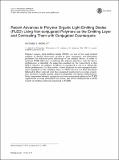Files in this item
Recent advances in polymer organic light-emitting diode (PLED) using non-conjugated polymers as the emitting layer and contrasting them with conjugated counterparts
Item metadata
| dc.contributor.author | Wong, Michael Y. | |
| dc.date.accessioned | 2017-08-07T15:30:09Z | |
| dc.date.available | 2017-08-07T15:30:09Z | |
| dc.date.issued | 2017-11 | |
| dc.identifier | 250524290 | |
| dc.identifier | 42a4ddde-c6a0-4e48-ac3b-d88f69eb60e8 | |
| dc.identifier | 85026908587 | |
| dc.identifier | 000412024000002 | |
| dc.identifier.citation | Wong , M Y 2017 , ' Recent advances in polymer organic light-emitting diode (PLED) using non-conjugated polymers as the emitting layer and contrasting them with conjugated counterparts ' , Journal of Electronic Materials , vol. 46 , no. 11 , pp. 6246-6281 . https://doi.org/10.1007/s11664-017-5702-7 | en |
| dc.identifier.issn | 0361-5235 | |
| dc.identifier.uri | https://hdl.handle.net/10023/11397 | |
| dc.description.abstract | Polymer organic light-emitting diode (PLED) is one of the most studied subjects in flexible electronics thanks to their economical wet fabrication procedure for enhanced price advantage of the product device. In order to optimize PLED efficiency, correlating the polymer structure with the device performance is essential. An important question for the researchers in this field is whether the polymer backbone is conjugated or not affects the device performance. In this review, recent advances in non-conjugated polymers employed as the emitting layer in PLED devices are first discussed, followed by their contrast with the conjugated counterparts in terms of polymer synthesis, sample quality, physical properties and device performances. Such comparison between conjugated and non-conjugated polymers for PLED applications is rarely attempted and hence this review shall provide a useful insight of emitting polymers employed in PLEDs. | |
| dc.format.extent | 36 | |
| dc.format.extent | 2187883 | |
| dc.language.iso | eng | |
| dc.relation.ispartof | Journal of Electronic Materials | en |
| dc.subject | Structure-property relationship | en |
| dc.subject | Polymer light-emitting diode (PLED) | en |
| dc.subject | Thermally activated delayed fluorescence (TADF) | en |
| dc.subject | Electroluminescence | en |
| dc.subject | QD Chemistry | en |
| dc.subject | T-NDAS | en |
| dc.subject.lcc | QD | en |
| dc.title | Recent advances in polymer organic light-emitting diode (PLED) using non-conjugated polymers as the emitting layer and contrasting them with conjugated counterparts | en |
| dc.type | Journal article | en |
| dc.contributor.institution | University of St Andrews. School of Chemistry | en |
| dc.identifier.doi | https://doi.org/10.1007/s11664-017-5702-7 | |
| dc.description.status | Peer reviewed | en |
| dc.identifier.url | https://link.springer.com/article/10.1007%2Fs11664-017-5702-7#SupplementaryMaterial | en |
This item appears in the following Collection(s)
Items in the St Andrews Research Repository are protected by copyright, with all rights reserved, unless otherwise indicated.

